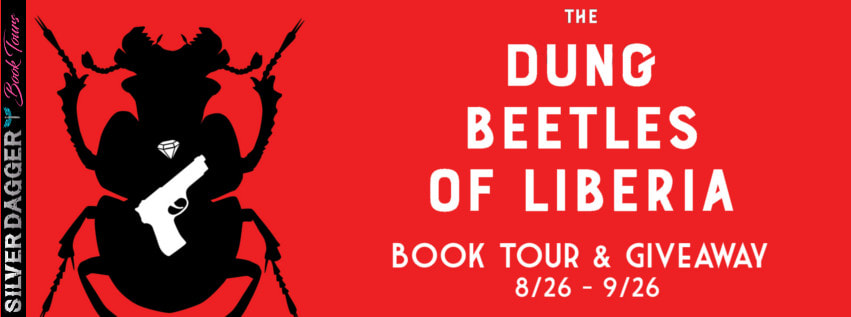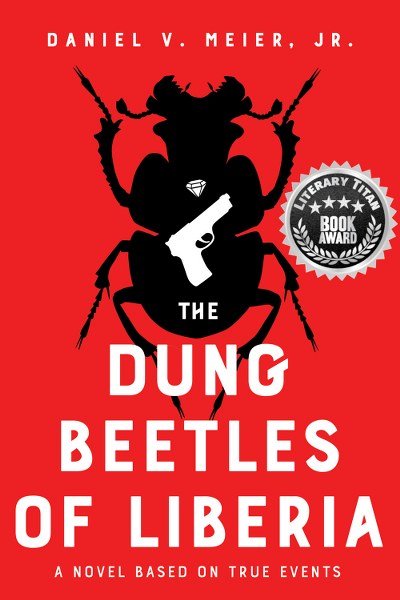The
Dung Beetles of Liberia
by
Daniel V. Meier Jr.
Genre:
Adventure, Historical Fiction
Based
on the remarkable true account of a young American who landed in
Liberia in 1961.
Ken
Verrier is not happy, nor at peace. He is experiencing the turbulence
of Ishmael and the guilt of his brother's death. His sudden decision
to drop out of college and deal with his demons shocks his family,
his friends, and especially his girlfriend, soon to have been his
fiancee. His destination: Liberia - The richest country in Africa
both in monetary wealth and in natural resources.
Nothing
could have prepared Ken for the experiences he was about to live
through. He quickly realizes that he has arrived in a place where he
understands very little of what is considered normal, where the
dignity of life has little meaning, and where he can trust no
one.
Flying
into the interior bush as a transport pilot, Ken learns quickly. He
witnesses first-hand the disparate lives of the Liberian "Country
People" and the "Congo People" also known as
Americo-Liberians. These descendants of President Monroe's American
Colonization Policy that sent freed slaves back to Africa in the
1800's have set up a strict hierarchical society not unlike the
antebellum South.
Author
Dan Meier describes Ken's many escapades, spanning from horrifying to
whimsical, with engaging and fast-moving narrative that ultimately
describe a society upon which the wealthy are feeding and in which
the poor are being buried.
It's
a novel that will stay will you long after the last word has been
read.
A
retired Aviation Safety Inspector for the FAA, Daniel V. Meier, Jr.
has always had a passion for writing. During his college years, he
studied History at The University of North Carolina Wilmington and
American Literature at The University of Maryland Graduate School. In
1980 he was published by Leisure Books under the pen name of Vice
Daniels. He also worked briefly for the Washington Business Journal
as a journalist and has been a contributing writer/editor for several
aviation magazines.
Dan
and his wife live in Owings, Maryland, about twenty miles south of
Annapolis and when he's not writing, they spend their summers sailing
on the Chesapeake Bay.
GUEST POST
 Standing
in front of a bug-a-bug hill
Standing
in front of a bug-a-bug hill
 photo
by Curtis Mekemson
photo
by Curtis Mekemson
Bug-a-bug and the Peace Corps
 Standing
in front of a bug-a-bug hill
Standing
in front of a bug-a-bug hill
John
F. Kennedy created
the Peace Corps in 1961 as one of his first acts as President of the
U.S. His thinking was both idealistic and pragmatic. No one could
argue against helping poorer countries combat poverty, hunger and
disease, and good deeds with volunteers’ boots on the ground with
western values could help stop the spread of communism. In 1961, the
Cold War was in full force and many of its battles were in third
world countries.
The Peace
Corps is
one of the most cost-effective use of our foreign aid dollars to this
day. And judging by the very rudimentary conditions the Peace Corps
volunteers in the Liberian settlements, it is easy to understand why.
Reading about the experiences of some Liberian Peace Corps volunteers
make our hero’s accommodations absolutely luxurious.
Below
are 2 edited excerpts from “The
Bush Devil Ate Sam”
by Curtis Mekemson, a Peace Corps volunteer serving in Liberia in the
1960’s:
“Americans
are of course familiar with the voracious appetite of termites, but
they may not be aware that termites in turn are considered to be
tasty treats by a substantial portion of the animal kingdom.
(Including humans.) The beginning of rainy season is when the
“bug-a-bugs” sprout wings and fly in the millions to set up new
colonies.
“Somewhere
in the middle of night, we woke up with rain pounding against our
shutters. At least we thought it was rain until we realized that it
was only pounding on one shutter, the one protected by our porch
roof. Curiosity led me to go exploring. When I opened the door, the
first thing I noticed was that we had left the porch light on. The
second was that the sky was alive with flying termites, all of which
seemed determined to land on the wall and shutters next to the light.
Once landed, they immediately begin to move downward, making room for
more bugs. I’m sure their greedy little minds were contemplating
the wood beams that held up the porch. Whether they could get to the
beams was something else. Every animal in the neighborhood including
[our dogs and cats] were scarfing up bug-a-bugs as fast as their
tongues and mouths could work. What they missed was being taken care
of by a huge army of toads that ranged in size from teeny-tiny to
humongous. There were so many termites that no one was going away
hungry.
“
The
next morning I headed out to survey the damage. Not a termite was to
be seen. It appeared that the animals and toads had hung around until
the last bug-a-bug had disappeared off the platter. I was eager to
get to school that morning so I could learn more about the termites
swarming habits from my students.
“What
I learned was that my students enjoyed eating the bug-a-bugs as
much as the animals. Many of the students, in fact, showed up in
class carrying cans loaded with the still alive and squirming
termites, which they proceeded to pop into their mouths for breakfast
as we went through the day’s first lesson.
“
 photo
by Curtis Mekemson
photo
by Curtis Mekemson
The
queens are best,” one of the students stated authoritatively and
was immediately backed up by a chorus of agreement. Queen termites
are huge egg laying machines with fist-sized abdomens capable of
popping out 30,000 kiddos a day. The Liberians caught them by tearing
apart the termite mounds. Appropriate eating etiquette involved
biting off their tails and sucking out their innards. Sweet meat
indeed!
“Later
that day I watched as [my neighbor] spread out mats for drying dead
termites. The termites were then stored away for later feasting.
Nothing edible was ever wasted in Liberia, whether it was meat
flying, meat running, meat swimming or meat crawling.”
###
“There
was a joke that circulated among Peace Corps volunteers on how to
determine whether you were [adapting]. Stage one: you arrive ‘in
country’ and a fly lands in your coffee. You throw the coffee away,
wash your cup, and pour yourself a new cup. Stage two: You’ve been
there a few months and a fly lands in your coffee. You carefully pick
the fly out with your spoon and then drink the coffee. Stage three:
It’s been over a year and you have become a grizzled veteran. A fly
lands in your coffee. You yank it out with your fingers, squeeze any
coffee it may have consumed back in your cup, toss the fly and then
drink the coffee. Stage four: You’ve been there too long. A fly
lands in your coffee cup. You yank the fly out, pop it into your
mouth and throw the coffee away. It’s time to go home!”
Follow
the tour HERE
for exclusive excerpts, guest posts and a giveaway!









No comments:
Post a Comment